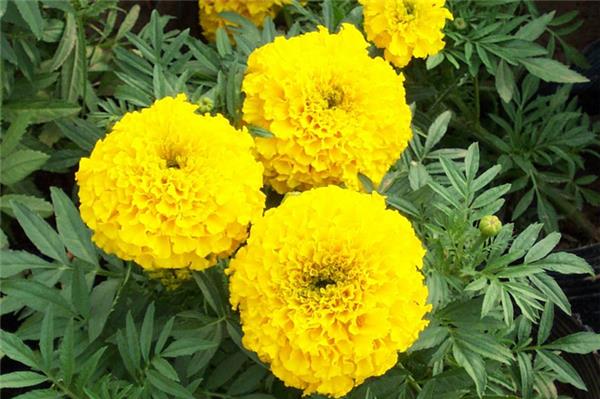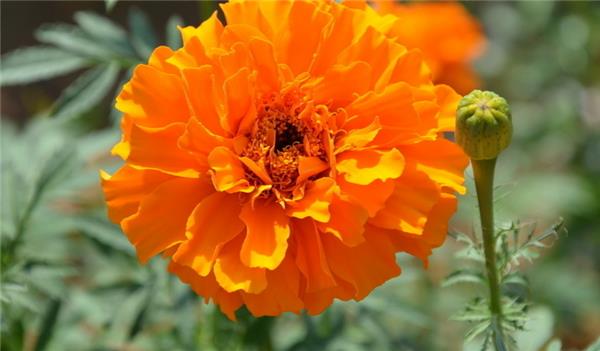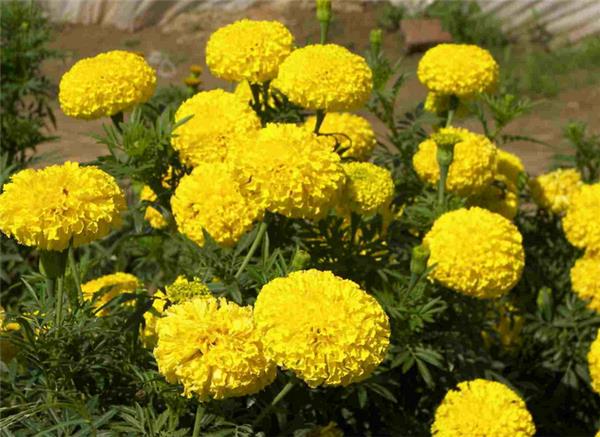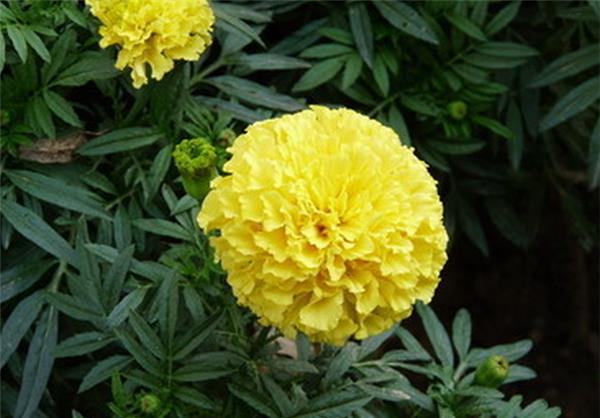Introduction and culture methods of flower marigold from Africa
Marigold is a kind of plant with strong vitality and can adapt to any kind of soil. Even the flowers with stems cut out are still as beautiful as ever. So its flower language is health. Next, let's take a look at the knowledge of marigold.

Introduction of marigold
Marigold is an annual herb with a height of 50-150 cm. It is an ideal raw material for extracting pure natural yellow pigment, which is called Khakibush in Africa. It is often seen hanging from indigenous huts to drive away swarms of flies.

2. Cultivation techniques of marigold.
Marigold sowed in spring and sowed in the open field from late March to early April. Because the seeds are too bright, they should be covered with soil and watered after sowing. The optimum temperature for seed germination is 20-25 degrees, and seedlings emerge one week after sowing, and the germination rate is about 50%. It can blossom 60 days after summer sowing. Marigold is planted in summer, it is easy to root and grow into seedlings quickly. Then, gradually move to a sunny place for daily management, and it can blossom in about a month.
Marigold seedling
1. Seedling raising time, area and seed consumption
The time of raising seedlings can be determined according to the time of transplanting. In general, spring marigold seedlings are raised about 40 days before transplanting, each planting 667 square meters of spring marigold requires a seedbed of 20ml / 25m2, and about 30g of seed is used.
two。 Seedling raising mode
Spring sowing marigold seedlings are raised in sunny beds or small arch sheds, and most of them are in small arch sheds. The seedbed chooses the leeward to the sun, and it is better to move from east to west. The width and length of the seedling bed should be film size and convenient management, and the general width should not exceed 1.3m. The height of arch shed should be about 60cm. The film had better choose the drip-free film with high temperature and good heat preservation performance. Marigold is often used to raise seedlings, and it can also be propagated by cuttings. The former method is mostly used for large-scale planting, while the latter method is often used for the cultivation of rare varieties. Seed seedlings can be sown all the year round, usually sowing autumn flowers in spring and autumn and winter flowers in summer. Seeds are easy to germinate and can be self-sown and propagated. From late March to early April, the soil was prepared to make beds, and the thickness of the covered soil was 0.8 m after sowing. Then water it with a fine-eyed spray can to keep the soil moist. The seedlings sprouted one week after sowing at 20-21 ℃, and there were 7 leaves in half a month, which could be transplanted at this time. The optimum temperature for seedling growth was 15 ℃. When the seedling height is 10-13 cm, it can be planted, and the plant distance is 30-35 cm. The vegetative growth period of early-maturing varieties is short, about 40 days, and that of late-maturing varieties is about 90 days, and the flowering period is 2 months. During the growing period from May to June, the young shoots with 3-4 nodes and 6-10 cm long were cut and inserted under the shade shed to raise seedlings. The substrate was washed with river sand or garden soil. Insert 2-3 meters deep to keep the soil moist. It took root after 2 weeks, came out of the nursery and planted after 3 weeks, and blossomed in about 1 month. When inserting a large number of oysters, the full light spray method is used, and the matrix can be made of perlite. As the spray increases the air humidity, the sun can not be shaded during the day after insertion, and the leaves left on the ear can be more than those of conventional seedlings. Take root for about 1 week, and then transplant.

3. Whole-bed fertilization
Marigold is not strict with soil, so we should choose soil with deep, loose, draining and breathable soil. The rake depth is 20-25cm, making the surface soil soft and fine, and the field smooth. Apply soil miscellaneous fertilizer 200kg, chrysanthemum special fertilizer 2kg to each kind of 667 square meter seedbed, turn the soil miscellaneous fertilizer into the ground, spread the chemical fertilizer evenly on the border surface, cut it into the ground with hoe, and then rake fine and level it.
4. Seed treatment
First select the seeds and remove impurities and blighted seeds to ensure that the seeds are full. Then the selected seeds were dried in order to kill bacteria, enhance seed vigor and improve germination rate. Before sowing, soak the seeds in 35 murmur40 ℃ warm water for 3-4 hours, then remove them and filter them with clean water, control dry water and sow. In order to prevent seedling diseases, methyl topiramate or chlorothalonil can be used to treat seeds.

5. Sowing seeds
Sowing should be carried out on a windless and sunny day. Fill the seedling bed with water on the sowing day and sow the seeds after the water seeps down. When sowing, mix the treated seeds in the fine sandy soil and spread them on the seedbed 2-3 times. After sowing, the sifted soil was covered with 0.7-1cm.
6. Watering
After cultivating the soil, water should be watered according to the soil moisture, each time the amount of water should not be too large, do not spread the ridge, and keep the soil dry and wet.
7. Extra-root topdressing
Extra-root topdressing was carried out when the flowers were in full bloom, and the best spraying time was after 6 o'clock in the afternoon. 30g urea and 30g potassium dihydrogen phosphate were sprayed every 667 square meters.
The above is the knowledge of marigold. I hope I can help you.
Related
- Wuhan Hospital Iron Tree Blooming Result Was Instantly Frightened by the Gardener Master
- Which variety of camellia is the most fragrant and best? Which one do you like best?
- What is the small blue coat, the breeding methods and matters needing attention of the succulent plant
- Dormancy time and maintenance management of succulent plants during dormancy
- Minas succulent how to raise, Minas succulent plant pictures
- What are the varieties of winter succulent plants
- How to raise succulent plants in twelve rolls? let's take a look at some experience of breeding twelve rolls.
- Attention should be paid to water control for succulent plants during dormant period (winter and summer)
- Watering experience of twelve rolls of succulent plants
- Techniques for fertilizing succulent plants. An article will let you know how to fertilize succulent plants.



